May 28, 2025 | 06:07 GMT +7
May 28, 2025 | 06:07 GMT +7
Hotline: 0913.378.918
May 28, 2025 | 06:07 GMT +7
Hotline: 0913.378.918
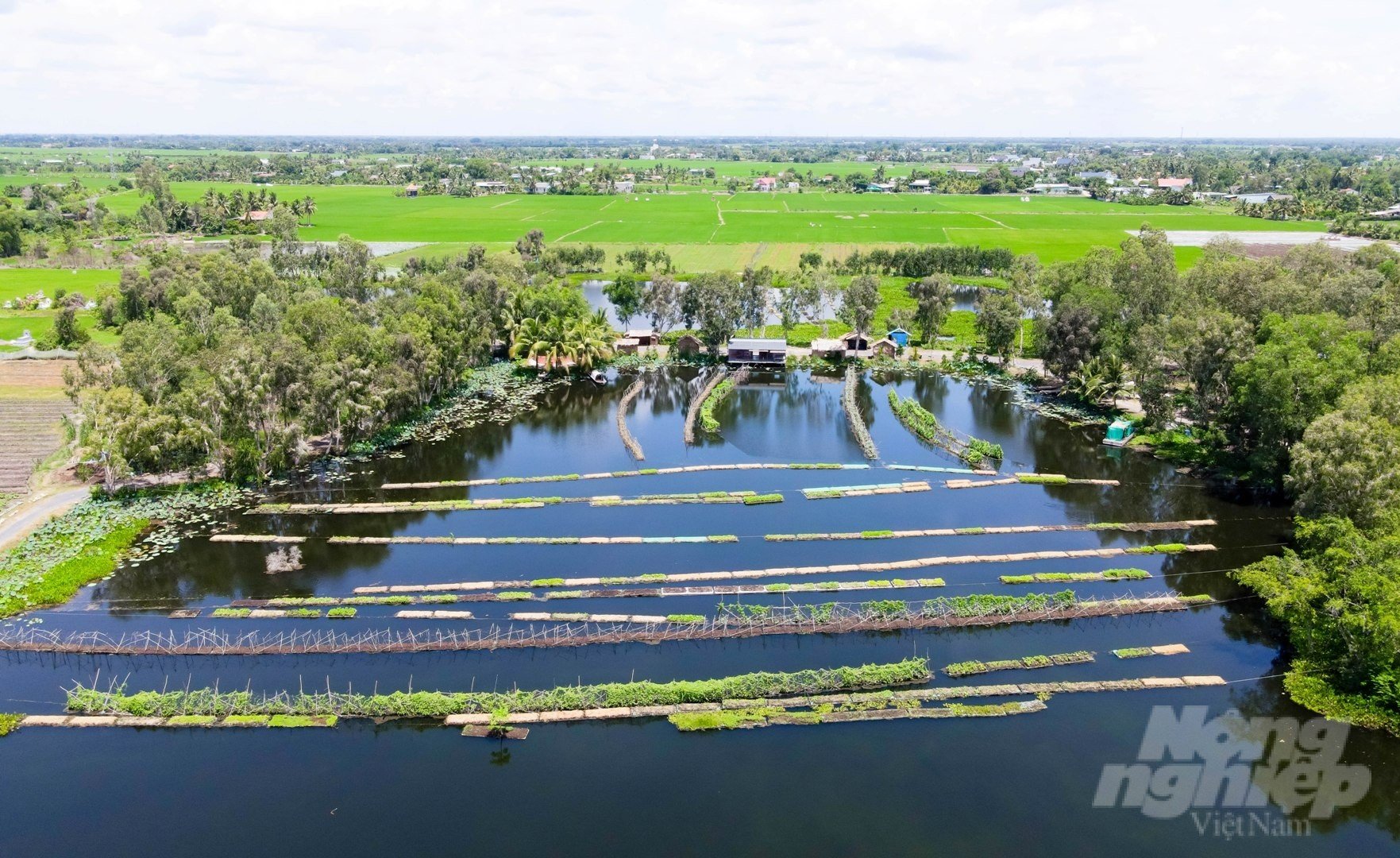
Overview of the Tam An Organic Farm of Mr. Nguyen Van Dac in My An commune, Thu Thua district, Long An province Photo: Le Binh.
The model of organically growing aquatic vegetables at Tam An Organic Farm of Mr. Nguyen Van Dac (My An commune, Thu Thua district, Long An province) has 400 lush green vegetable plots including gourd, squash, sponge gourd, tomato, bitter gourd, onion, and green stuff of all kinds grown on the floating rafts on the lake surface.
These vegetable plots are grown on rafts made of plastic bottles, water hyacinth, and straw. In fact, this model has been widely applied in some Asian countries, but this is probably a rather rare form of farming in Vietnam.
Mr. Dac shared that he was originally interested in organic farming but had little production land, so he could not pursue his passion. Realizing that Long An has a large water surface area along with dense water hyacinth, he has tinkered with designing floating rafts to grow vegetables.
Each raft was designed with an area of 3 m2 (1m horizontally and 3m vertically), made of plastic bottles and net, and fixed with a bamboo frame. The raft surface is covered with by-products from dried water hyacinth and straw composted with organic fertilizers. To fix the rafts, Mr. Dac tied them together and fixed them to the shore.

Currently, about 400 rafts of vegetables, including gourd, squash, sponge gourd, tomato, bitter gourd, onion, and green stuff of all kinds, grown according to the hydroponic organic method, are being harvested. Photo: Le Binh.
After many months of success with the model of growing aquatic vegetables on the lake, Mr. Dac realized that this method is much easier to grow than traditional cultivation on soil or hydroponics. Simply because in this farming method, the crops will self-absorb water according to their needs and take nutrients from microbial organic fertilizers composted from water hyacinth, straw, etc.

Growing aquatic organic vegetables on the water surface is considered a new direction for localities with large water surface areas and water hyacinths. Photo: Le Binh.
In addition, the growing method with plots on the water surface has the advantage of isolating vegetables from harmful insects, reducing the need to handle pests by up to 80% compared to growing on the shore. With this method, Mr. Dac absolutely does not have to use pesticides, so it is both leisurely and cost-effective, ensures safety for consumers, and contributes to protecting the ecological environment.
After many failed attempts, Tam An Organic Farm has now successfully grown 400 rafts of aquatic vegetables on an area of 3,000 m2 of water surface. The farm’s average yield reaches 300–400 kg of vegetables and fruits of all kinds, with a selling price of VND 40,000/kg or more (depending on the type).
"Our main consumption market is in Thu Thua district and Tan An city (Long An province). Currently, our farm is also stably providing vegetables in the long term for a supermarket chain in Tan An City. Consumers’ support for our products is the greatest happiness," shared Mr. Dac.
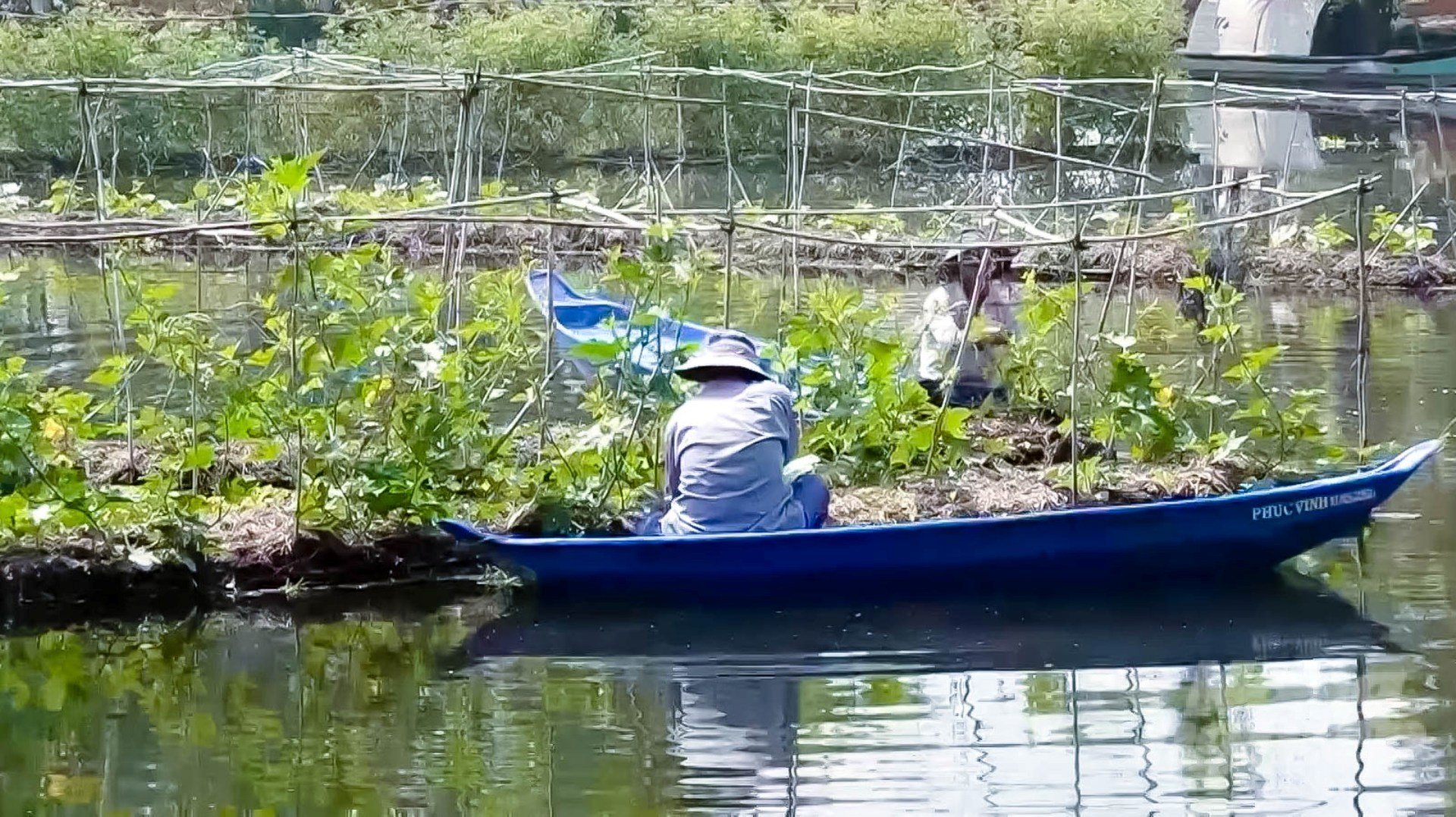
The farm is creating stable jobs for about 10–12 workers with a good income. Photo: Le Binh.
Mr. Lam Cuong (living in Vinh Chau district, Soc Trang province) is one of 12 workers at Tam An Organic Farm, specializing in growing and taking care of aquatic vegetables. Mr. Cuong said that "The work here is year-round stable, and aquatic vegetables are easier to care for and have fewer pests than onshore vegetables. Every day, we mainly make more rafts, grow more vegetables, and harvest vegetables rather than spraying pesticides because the vegetables grown on the raft are very pest-free."
The wish of Tam An Farm owner is not only cultivating vegetables but also turning this place into an ecological tourist and resort area, which will be a peaceful place for those who love nature and want to learn about the method of growing aquatic vegetables.
"We hope that this place will be able to serve people and research groups to visit, research organic agriculture, and enjoy purely natural agro-products," said the owner of Tam An Organic Farm.
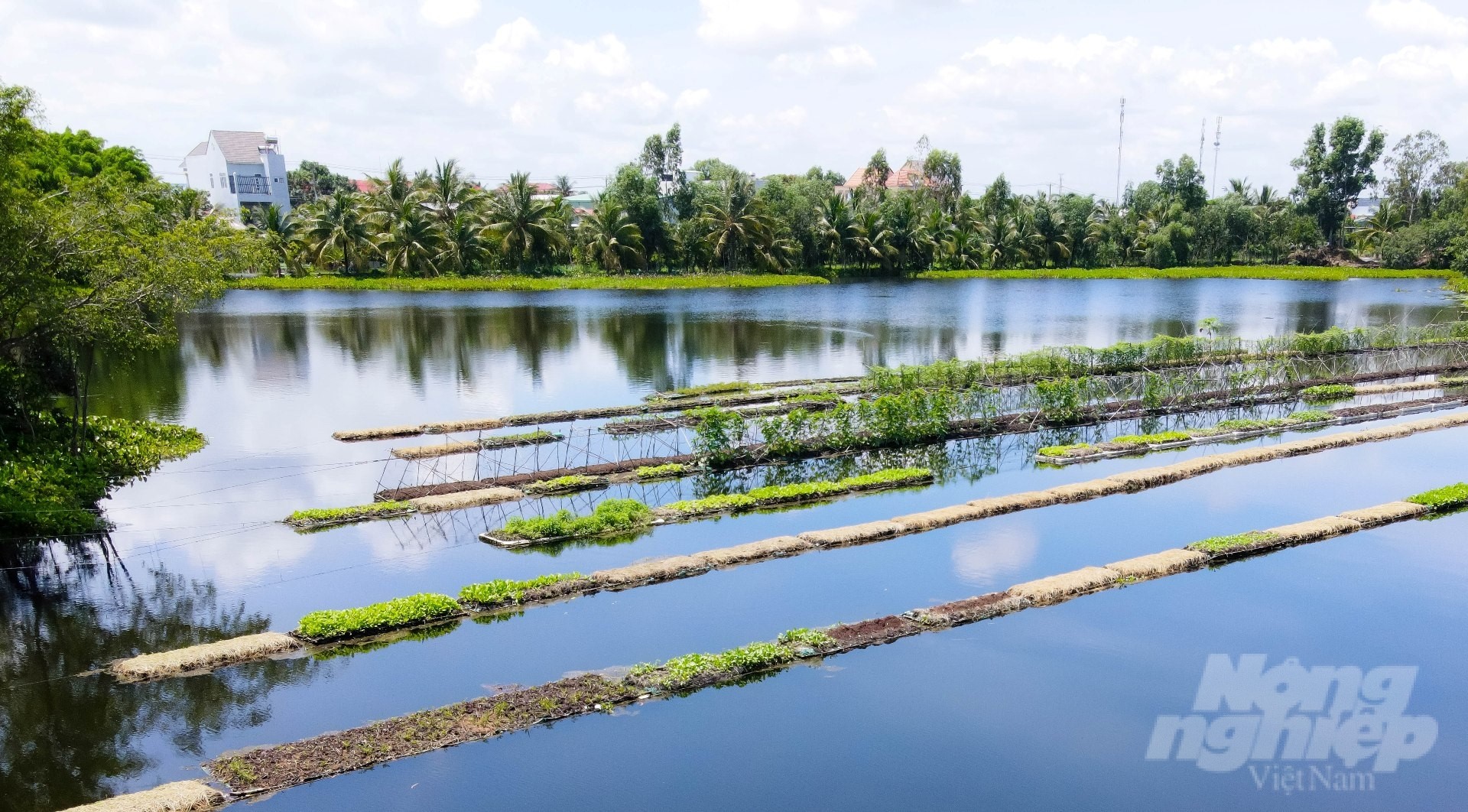
The vegetable rafts are very pest-free. Photo: Le Binh.
Ms. Dinh Thi Phuong Khanh, Deputy Director of the Long An Department of Agriculture and Rural Development, proudly said that the aquatic production model of Tam An Organic Farm is considered a bright spot in Long An province, opening up many new directions for the province’s agriculture sector.
"This model is not new, nor has it proven to outperform what we have seen from the traditional model of cultivation on land. However, it opened up for the Long An people a new direction, which is easy to do and very successful.
Long An has an abundant source of water hyacinth, a vast surface of the Vam Co Dong river, many ponds and lakes, especially abandoned ponds and lakes after the exploitation of land for construction materials, and many used plastic bottles piled up in bottle racks. That's all for this model to expand and promote its effectiveness," said Ms. Khanh.
However, from a professional perspective, Ms. Khanh also recommended that this model of growing aquatic vegetables only be applied in ponds and lakes, where the water surface is still and the pH is relatively stable. When deciding to farm in the river, it is necessary to consider the impact of currents, waves from ships, and an unstable pH.

Agro-products on the farm are directly consumed at local markets and supermarkets, with an average output of 300–400 kg/day. Photo: Le Binh.
On the upstream side of the Vam Co Dong River, Tay Ninh province is also similar to Long An province, with an abundant source of water hyacinth and a large neglected river and canal surface area, so this province is also relatively suitable for the development of growing aquatic vegetables.
Sharing about Mr.Dac’s model of growing aquatic vegetables in Long An provinces, Mr. Nguyen Dinh Xuan, Director of the Tay Ninh Department of Agriculture and Rural Development, expressed his surprise and interest in the effectiveness of this model.
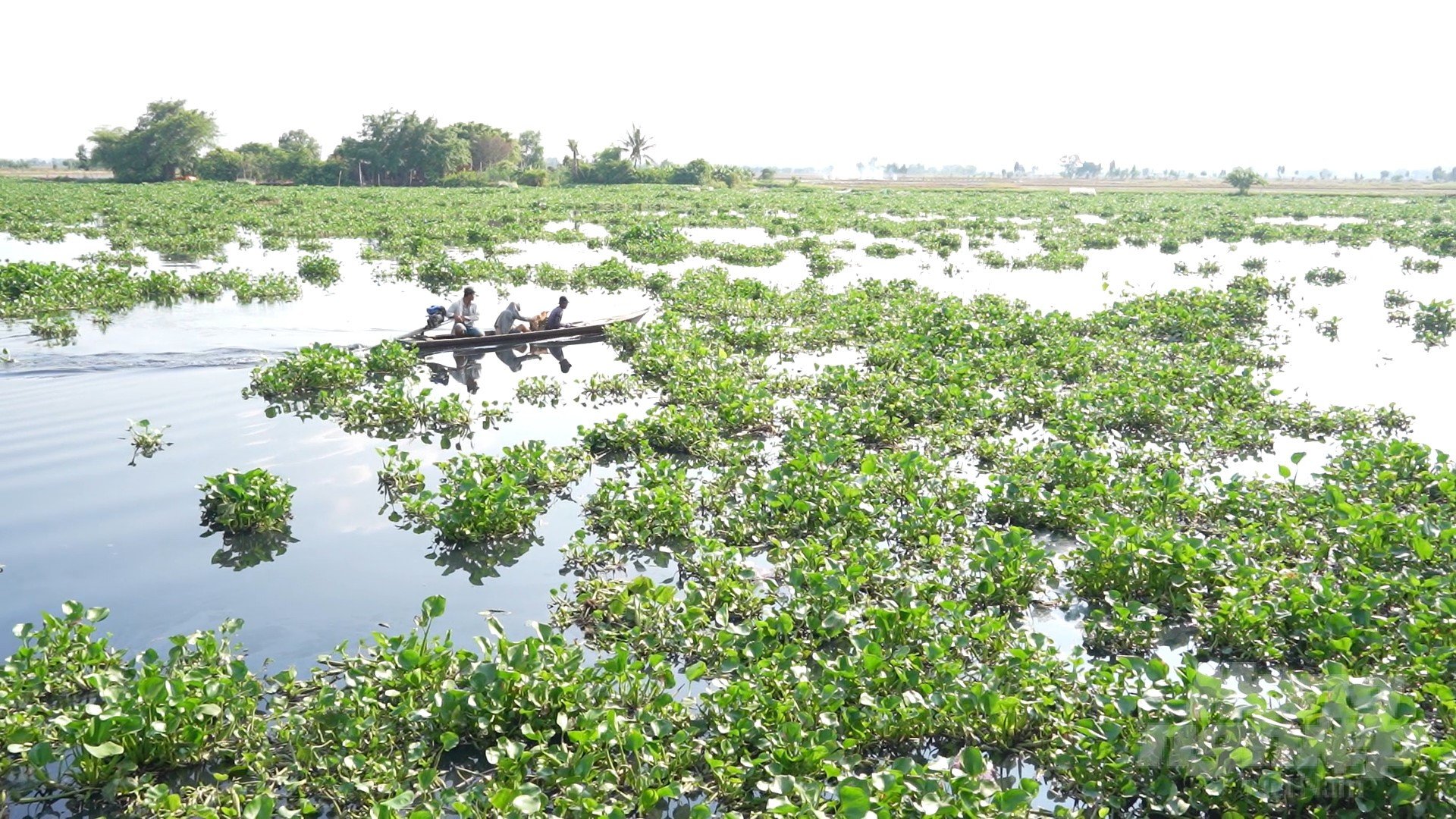
The method of growing aquatic organic vegetables is relatively suitable for Tay Ninh, which has many rivers and canals and an abundant source of water hyacinth. Photo: Le Binh.
"This is also a proof of effectiveness for us to have more practice to follow. The model also creates opportunities for Tay Ninh farmers to take a new direction in developing vegetables and fruits with low investment costs and taking advantage of many inherent advantages. In the coming time, maybe we will send the Provincial Agricultural Extension Center to record and study to disseminate to people, "said Mr. Xuan.
Tay Ninh's climate is warm and sunny, the water source is year-round abundant, and water hyacinth is always in excess and needs to be treated. These are "plus points" so that Tay Ninh's agriculture sector can receive new farming methods suitable for many types of crops.
Translated by Huyen Vu Thu
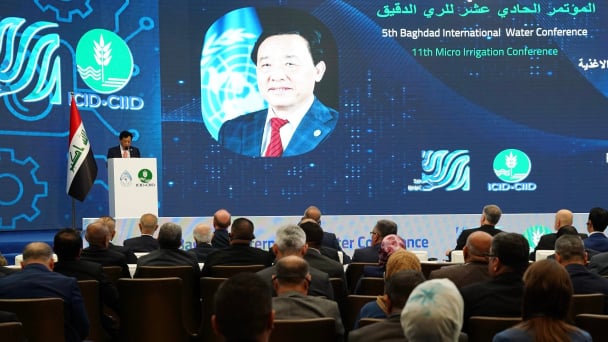
(VAN) FAO’s Director-General addresses the 5th Baghdad International Water Conference.
/2025/05/26/1716-4-nongnghiep-191706.jpg)
(VAN) Chain linkages, technological innovation, and raw material zoning are three strategic pillars for the coconut industry to strongly develop and elevate its position on the global agricultural map.
![Advanced mariculture – an inevitable trend: [4] Accompanied by scientists](https://t.ex-cdn.com/nongnghiepmoitruong.vn/608w/files/sohk/2025/05/13/1941-pgsts-vo-van-nha-140958_717.jpg)
(VAN) According to Assoc. Prof. Dr. Vo Van Nha, Director of the RIA III, the development of advanced offshore mariculture is no longer an option but an essential path for Vietnam’s fisheries sector.

(VAN) Vietnam is intensifying the development of mollusk farming areas that meet international standards, aiming for sustainable growth and enhancing its export position in the global seafood market.
![Advanced mariculture – an inevitable trend: [3] Policy-driven momentum](https://t.ex-cdn.com/nongnghiepmoitruong.vn/608w/files/doanhtq/2025/05/21/0104-0616-0348-nuoi-bien-170339_789.jpg)
(VAN) To ensure the success of offshore mariculture that uses advanced technologies, it is essential to establish supportive policies that inspire both individuals and enterprises to invest with confidence.
![Advanced mariculture – an inevitable trend: [2] Outstanding results](https://t.ex-cdn.com/nongnghiepmoitruong.vn/608w/files/sohk/2025/05/12/4632-4136-nuoi-bien-11-164117_819.jpg)
(VAN) Pilot models of high-tech offshore mariculture in Vietnam, particularly in the South Central Coast region, have demonstrated exceptional economic returns and sustainability, setting a new direction for the country’s aquaculture industry.
![Advanced mariculture – an inevitable trend: [1] Moving offshore](https://t.ex-cdn.com/nongnghiepmoitruong.vn/608w/files/phucpm/2025/05/18/0252-2436-nuoi-bien-6-162148_783.jpg)
(VAN) Mariculture using advanced technology and moving offshore is an inevitable trend, as nearshore areas increasingly reveal limitations.